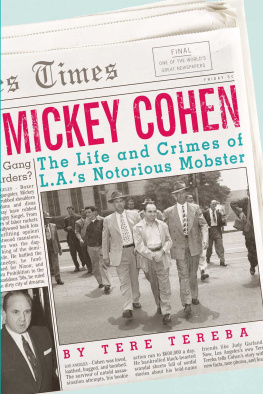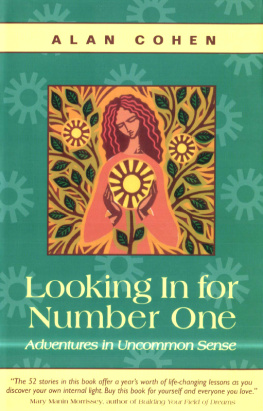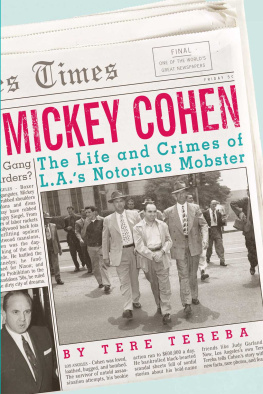Prologue
A Dangerous Place
Sherrys
9039 Sunset Boulevard
Los Angeles County, California
July 20, 1949
It was well after midnight and twenty-one-year-old Shirley Temple had just spent another late night at Sherrys, the after-hours nightspot on the Sunset Strip. When the attendant delivered her navy blue Cadillac, the beautiful former child star slipped behind the wheel and drove west on Sunset Boulevard, toward her home in Brentwood. She had driven several miles before she observed a mans fedora on the seat beside her.
Pulling to the curb, I inspected the hat carefully, found no identification, then noticed the car upholstery was not mine, she explained. On the floor in the back lay a long, locked, black leather case, soft to the touch but with something hard inside... When I returned to the nightclub, the valet tumbled over himself with gratitude. What he had delivered was Mickey Cohens look-alike Cadillac.
* * *
Two years earlier, in 1947, Mickey Cohen had become Los Angeless most prominent underworld figure. Standing five-foot-five in his custom-made elevator shoes, the pudgy, squat-legged former prizefighter was now as much a part of the local color as movie stars, palm trees, and smog. Having grown into a figure of immense fascination to the public, his exploits were constant headline-makers. L.A.s Capone he seemed able to get away with murder. Many assassinations were ascribed to him, and in the past year alone, there had been multiple heavily publicized attempts on his life. Cunning, ruthless, and flamboyant, at thirty-five, Mickey Cohen was at the center of an ongoing underworld war and major political upheaval.
Police, political figures, and members of the underworld had all heard the story: Cohen was again slated for assassination. The local Mafia wanted him dead, while another rival offered an apartment house as compensation for accomplishing the deed. A cadre of rogue cops had vowed to kill him, and members of his own gang were eager to displace him. Threatening to end the careers of an array of LAPD brass and prominent officials, he was scheduled to appear before a grand jury investigating police corruption.
After dining with a lobbyist considered to be Californias political kingmaker, Mickey turned up at Sherrys. It was common knowledge the no-frills, smoke-filled restaurant was his favorite last-round hangout. Resplendent in an impeccably tailored pigeon gray suit, he settled into his regular spot, booth #12. Back to the wall, he sat surrounded by members of the press. The journalists he entertained were following him, anticipating high drama. While satisfying his addiction to chocolate ice cream, Mickey held court, kibitzing with them in his unique patois of fractured grammar and four-syllable words. Florabel Muir, the veteran newswoman who had become his covert advocate, asked him if it was dangerous to be clubbing.
Not as long as you people are around, the mobster told her. Even a crazy man wouldnt take a chance shooting where a reporter might get hit. Knocking wood, he added, Youre too hot.
It was nearing 4 a.m. when plans for his exit began. Flanking the exit were plainclothes police, a sergeant from LAPDs Gangster Squad, and Special Agent Harry Cooper, the high-ranking state officer who, in a stunning move, had recently been assigned by Californias attorney general as Cohens bodyguard. Seeing the lawmen at the door, journalist Muir jokingly said to them, What are you standing out here for? Trying to get yourself shot?
Given an all-clear signal, Cohen and his party, accompanied by a phalanx of bodyguards from both sides of the law, moved onto the neon-lit Strip. Muir lagged behind, stopping to buy the morning edition of the Examiner . As she picked up the paper, the journalist heard a volley, then another. Looking out the door, what she saw unfolded like a movie.
A few feet away, a screaming man and young woman lay sprawled on the sidewalk. As the fusillade continued, she watched Cohen, blood darkening the shoulder of his jacket, shout commands. Then the state officer was hit. Clutching his stomach, Special Agent Cooper was still gripping his revolver as Cohens men struggled to pull him into a car. The wounded mob boss took charge, hoisting the hulking cop into the back seat as the big sedan roared into the night.
This was the sixth of eleven attempts on the Hollywood mobsters charmed and violent life. Nearly thirty years later, at the end of nearly sixty years of crime, Mickey Cohen would die peacefully in his sleep, outliving many formidable assassins and all his prominent enemies, as well as his legendary sponsors, Bugsy Siegel, Frank Costello, and Lucky Luciano, as the most brazen and colorful gangster of them all.
Act I
THE CALIFORNIA WILDCAT
1
BOYLE HEIGHTS BOYCHIK
If anyone called someone a kike, spic, or wop in our neighborhood, we would beat his head in.
Mickey Cohen
Among waves of Jewish immigrants escaping the poverty and anti-Semitism experienced in czarist Russia, Mickey Cohens parents, Max and Fanny, made their way to the United States in the first years of the twentieth century. Indigent, uneducated, and unable to speak the language, the couple settled into the ghetto neighborhood of Brownsville, Brooklyn.
Max Cohen was in some kind of import business with Jewish fishes, as Mickey would later describe his fathers occupation. There were already five children in the household, three older boys and two small daughters, when Meyer Harris called Mickey arrived on September 4, 1913. Max died two months later. His youngest child had no memory of him. Told his father had been a good provider who adapted quickly in America, Mickey Cohen later portrayed his father as a man of religion and integrity. According to the rest of the family, he said, he was orthodox in his faith and very orthodox in his attitude toward the sanctity of the family and home.
Left with six children, and little else, in 1915 Fanny boldly embarked to Los Angeles, Americas newest city. Leaving the older children with relatives, Mickey, barely two, and Lillian, his four-year-old sister, accompanied her.
By then, Los Angeles had already tasted boom times. Founded in 1781 by Spanish missionaries, the region was controlled by Mexico beginning in 1821, until it became a territory of the United States after the Mexican-American War of 1846. Dramatic change would not happen until decades later, when in 1876 the Southern Pacific Railroad transformed the geographically isolated cow town. With the opening of the railroad, commerce began to flourish, making Los Angeles a viable destination for tourists and settlers. Then oil was discovered. With people flooding the area, real estate development and speculation took off.
Located eight miles west of downtown, Hollywood was one of scores of new hamlets that sprang up in the patchwork of empty land, orange groves, and oil and bean fields that defined the sprawling, yet sparsely populated, city of Los Angeles. Using his political clout, William H. Workman, who later became mayor of the city, proposed a development for the white-collared middle classes two miles east of downtown. After a bridge linking the area to the central city was built across the Los Angeles River, ground was broken in 1875. Situated on a bluff, with commanding views of downtown to the west, the community of Boyle Heights was born.
Boyle Heights was Fanny Cohens destination. By the time she arrived, due to discriminatory residential laws and escalating prices in other areas, the neighborhood had devolved into the citys melting pot. Populated by immigrants, mainly Eastern European Jews and also Mexicans, Italians, Russians, Japanese, and Chinese, the narrow streets were dotted with tiny one-story houses. The run-down frame cottages were no different from those in the oldest sections of Hollywood or the shotgun shacks of Venice-at-the-Sea, the beachside village at the end of the Pacific Electrics Red Car line. But culturally Boyle Heights developed a much different tone.







